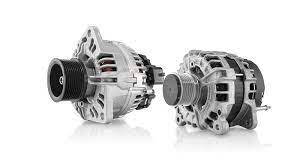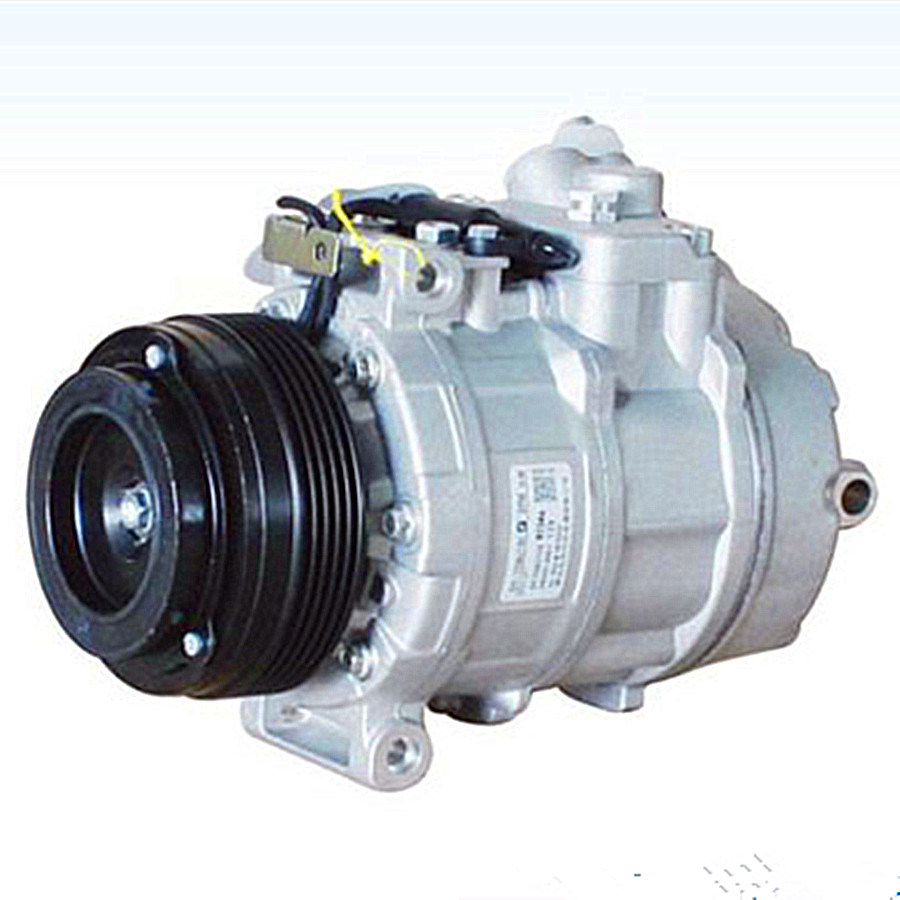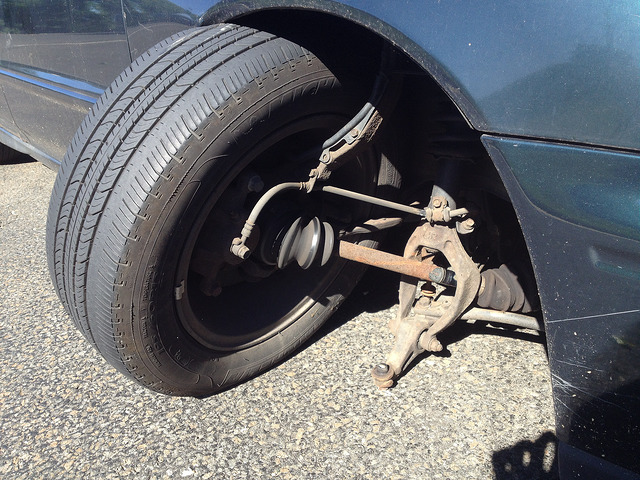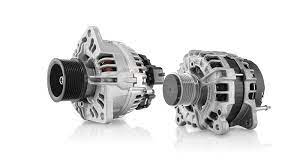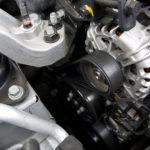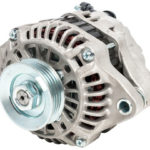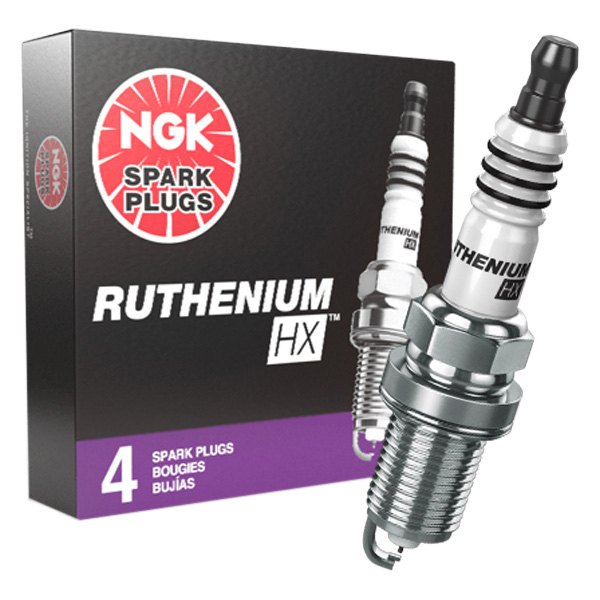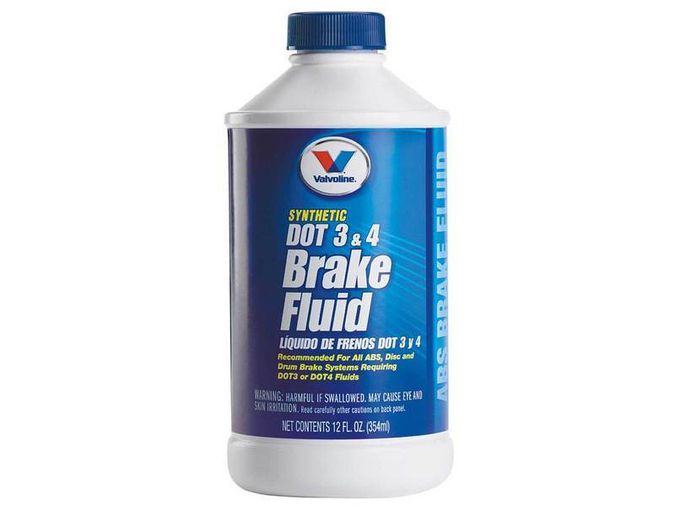Our guide today will focus on the top 7 signs of alternator failure. In other words, if you see these signs occurring in your car, then you should know your alternator has problem and you need to get a mechanic as soon as possible. Before I show you these signs, I will want us to consider what an alternator is and the role they play in the car.
What Is a Car Alternator?
An alternator is a vehicle’s electric power generator and a key component of the charging system. Except for some hybrids, every car with an internal combustion engine has an alternator. The alternator charges the battery and gives additional electric power to the vehicle’s electrical systems when the engine is running. A serpentine belt drives an alternator that is mounted to the engine (drive belt).
An alternator is a unit that does not require any maintenance. It can endure up to 10-15 years in some autos without needing to be repaired. If the alternator dies, the automobile may still be able to function on battery power for a short time. The engine, on the other hand, will stall.
What Does a Car Alternator Do?
While the battery is necessary for starting your automobile after it is turned off, the alternator keeps your car running. While driving or idle, the alternator powers most of your car’s electronic components, including your headlights, electric steering, power windows, windshield wipers, heated seats, dashboard instruments, and radio. The alternator provides direct current (DC) electricity to all of them. Your alternator is also in charge of charging your automobile battery while you’re on the road.
While the battery is required to start your vehicle when it is turned off, the alternator converts mechanical energy into electrical energy. When your engine is turned on, it drives a drive belt that is coupled to an alternator pulley. The alternator’s rotor shaft is rotated by the pulley, which rotates a series of magnets around a coil. The alternating current (AC) generated by these spinning magnets is then directed to the rectifier of the alternator. The rectifier converts AC power to DC electricity, allowing your car’s electrical systems to operate.
While the battery is necessary for starting your automobile after it is turned off, the alternator converts mechanical energy into electrical energy. Alternators are designed to last the life of your vehicle, but this is not always the case. General wear and tear, heat damage, abuse, water exposure, faulty parts, and frayed wires can all cause your alternator to fail before your automobile is scrapped.
Let us now consider the signs of alternator failure:
Read also: Top 10 Best Catalytic Converter Cleaner
Signs Of Alternator Failure
The following are the signs of a faulty alternator. If your car starts showing these signs then you should know that your alternator is bad:
Difficulty Starting Car
Because each automobile is unique, difficulties starting or keeping your car running is likely to be one of the first signs of alternator failure. However, stalling or hard starts can be caused by a variety of mechanical faults. It’s critical to consider everything else going on with your vehicle in order to pinpoint the issue.
Because every automobile is different, trouble starting or keeping your car running is likely to be one of the first issues you encounter. If your hard starts are due to alternator problems, the explanation for this is that the automobile begins from the battery’s stored energy. As previously said, if the alternator is not correctly charging the battery, the battery will not be strong enough to start the automobile confidently and smoothly. If the automobile stalls after it has been running for a while, the spark plugs may not be receiving enough electricity from the alternator to keep the engine running. In other words, your battery isn’t completely dead yet, but it’s close.
Because every automobile is different, trouble starting your car or sharp-eyed readers may recall that a dead battery was noted as a separate symptom previously in this list, despite the mechanical elements being comparable. Is it really necessary to bring this up individually, you may wonder? Yes, because it’s far simpler to ignore or miss a fading battery than it is to ignore or overlook a dead one, and if you know what this symptom implies, you can have your alternator checked out before you become stuck.
Slow Car Accessories
Because every car is different, you may have trouble starting your car or remember that a dead battery was formerly a common problem. Are you having trouble getting your power windows to open or close when you give them a simple command? Is it possible that the stereo is swallowing CDs, or that the power sunroof is jammed open? Modern automotive features are fantastic until they aren’t, and the complicated computers and wiring systems that control our power accessories increase the likelihood of something going wrong.
Of course, any of these features could malfunction at any time. Motors fail, wires cross, and a variety of other issues can arise. If you discover any electrical anomalies, you should have that feature looked out. However, if you’re having multiple problems at the same time, it’s most likely not a coincidence.
Your alternator is one of the most common causes of electrical problems, and you may not realize it until you put more demands on the system, such as turning on an interior light or trying to adjust your windows, that your car is running with lower electricity. To lessen the likelihood of genuine alternator failure, avoid using these features as much as possible until you can get your car looked out.
Bad Strange Odor
The next sensory symptom of alternator trouble is a foul odor, which indicates that your alternator is working too hard and is about to overheat. Have you ever been in the vicinity of a power line fire? That’s how an overworked alternator might smell. An overheated alternator, which is pushing too much power through the rotor and stator, might give off a hot wire odor.
Or smoldering rubber? Yes, thanks to the rubber belt that keeps the alternator running and the rubber sheaths on the wires that connect everything in your electrical system, it’s another possibility. A pulley that is out of alignment or not turning freely can cause greater friction on the belt, resulting in heat and a burning rubber odor. Your nose will most likely alert you if they become too heated.
Not all foul odors indicate a problem with the alternator. The fragrance is unique from other notable automotive odors, such as the smoky sting of burning oil, the pleasant odor of overflowing coolant, or the singe of overheated brakes. Of course, none of these things are good, so have them checked out if you smell any of them. Also, just because there isn’t a terrible odor doesn’t mean everything is fine. In other words, a poor electrical stench can help you pinpoint the root of your problem, but it’s also possible that the alternator is failing without any of these aromas.
Strange Noise
If the sight of a failing alternator isn’t enough to alert you (and that’s understandable), the sound could. Before an alternator fails, drivers may complain about hearing a “growling” or “whining” noise. In conjunction with the crankshaft pulley, an accessory belt or a serpentine belt drives the alternator. To create the power required at lower engine speeds, such as idle, the alternator pulley normally rotates two or three times faster than the crankshaft pulley. The alternator pulley revolves around a shaft that is supported by bearings or bushings. The growling or whining noise will alert you to a problem if the pulley is not in proper alignment with the belt, is canted on the shaft, or the bearings and bushings are worn out.
Because many automotive problems generate peculiar noises, this symptom is most useful when combined with other symptoms, especially since identifying the source of a sound while driving can be difficult.
If your alternator has failed to the point where it has damaged your engine, you may hear noises from within the engine due to broken engine bearings. Engine damage is one of the worst-case situations for alternator failure, and it is certainly possible, but keeping a car running with a damaged alternator is so difficult and uncomfortable that you’ll probably get it serviced long before it causes harm to your engine.
Faulty Belts
Customers frequently complain of classic alternator problems, only to open the hood and discover the belt missing, dangling from the engine block, or fluttering around the engine compartment. Take a look under the hood to check whether your car has any of these difficulties, even if you aren’t experienced enough to fix them yourself, because a broken or loose belt is quite evident.
If you’re familiar with your car’s components and can perform basic maintenance, you’ll be in good place to spot a problem before it leaves you stranded. A brief visual inspection of the belt for cracks, excessive wear, and other signs of age can indicate a future problem. Keep in mind that the belt must be properly tensioned to properly drive the alternator; too much tension is just as harmful as not enough tension. A cursory check of the belt tension is generally sufficient to detect whether or not there is a problem. Before touching anything behind the hood, make sure your automobile has cooled down.
Loose Or Broken Connections
In this situation, everything with your car’s alternator appears to be in working order — no apparent symptoms of wear or tear — yet the car’s battery, as well as most of the electrical equipment, is dead. That could indicate that the alternator is producing energy, but it isn’t moving or isn’t the correct type.
Large cables and smaller wires carry the electricity from the alternator. Any issues with the wires, cables, or connectors on either end can decrease or prevent the flow of energy. Brighter lights may be a symptom of this problem since the alternator produces more energy to overcome resistance in a defective wire or a damaged or loose connection. This symptom is frequently accompanied by a strong odor of hot wires. Higher resistance within a wire generates heat, much like how an electric stove burner generates heat by resisting the flow of electricity.
Another issue could be the diode rectifier in the alternator. Alternators create three-phase alternating current (AC) power, while the car’s accessories require direct current (DC). The rectifier converts AC current to DC current. The electricity produced by the alternator cannot be used unless that key component is working properly.
Dead Battery
A car that won’t start is a sure clue that there’s an issue with the starting system, even if it isn’t strictly an alternator problem. When the key is turned, a familiar clicking sound of relays ticking over is heard, but nothing else happens. Even that noise fades away after a while. The immediate issue is usually a dead battery, but you must first determine why it is dead.
Instead of operating as a capacitor for the system by receiving a steady infusion of electrical power from the alternator, when the alternator begins to falter — or fails completely — the car’s battery begins to pick up the slack. Even the greatest automobile battery will eventually run out, leaving you stuck in your driveway or, worse, on the side of the road. Car batteries aren’t meant to be used for extended periods of time. They’re meant to give your vehicle enough electrical oomph to start by delivering a burst of electricity to the starter motor and getting everything spinning. To put it another way, a defective alternator can draw your attention by causing your car’s battery to die, even if the battery wasn’t the issue in the first place.
It’s quite simple to distinguish between a dead battery and a dead alternator. Simply jump-start your vehicle and then swiftly remove the jumper cords. Then you must wait. If the alternator isn’t charging the system, the car will die again, and you’ll know what’s wrong. If, on the other hand, the car starts and continues to run, the fault is most likely with the battery.
However, use caution because a dying battery can only receive a charge for so long before going fully dead, despite the alternator’s best efforts. A voltmeter may be used to test the battery, and most auto dealers have capabilities to examine a problematic battery for free.
Dim Or Flickering Light
Alternator problems are often manifested by dim outside and interior lighting. It’s possible that your lights are flickering rather than being dim. These two symptoms are frequently associated, but not always. If your lights flash brightly, then dimly, then flash brightly again (on a regular basis or seemingly at random), you have an electrical problem, and the alternator is the most likely culprit.
The logic is the same as if the lights were merely dim – the alternator isn’t producing enough electricity to keep the lights running at full strength, so instead of dimming all of the lights, your automobile is attempting (and failing) to maintain the proper illumination output.
Simply check for a pattern if you want to be sure the problem is with the alternator and not something else in the electrical system. Is it possible to pinpoint when the lights flicker when you do something else that uses electricity, such as listening to the radio, adjusting the climate control, or using your power windows? That will be crucial in narrowing down your options because it shows that your lights are flickering in reaction to the increased demand on the system.
After seeing the signs of alternator failure, we now want to consider some common causes of alternator failure:
Causes Of Alternator Failure
The following are the common causes of alternator failure:
Wiring Problems
The alternator is powered by a network of wires throughout the car. If one of these wires becomes damaged or worn out, the alternator may fail to function properly, resulting in the battery not being charged. If none of the other issues listed below are present in your car, check the wiring of the alternator, as this could be the cause of the alternator not working.
Faulty Fuse
Fuse boxes are used in vehicles to keep the alternator running. After a while, or if there is a power surge, these fuses will burn out. Your alternator would fail under these situations, and your battery would not charge. If your alternator fails, check the owner’s manual to verify where the alternator fuse is located in your vehicle and whether it is blown.
Broken Belt Or Pulley
Alternators generate electrical energy for a vehicle by using the mechanical power of a belt and pulley. The problem is that the alternator belt and pulleys are not very sturdy, allowing them to break easily.
Pulleys normally survive a long period before being damaged due to wear and tear. Belts are flimsier and, given enough time, will begin to crack and even snap. There would be no mechanical energy generated for the alternator to convert if one of these situations happened.
Conclusion
Hope you enjoyed reading this article on signs of alternator failure. Do well to contact your mechanic if you notice any of the following signs listed in this article.

